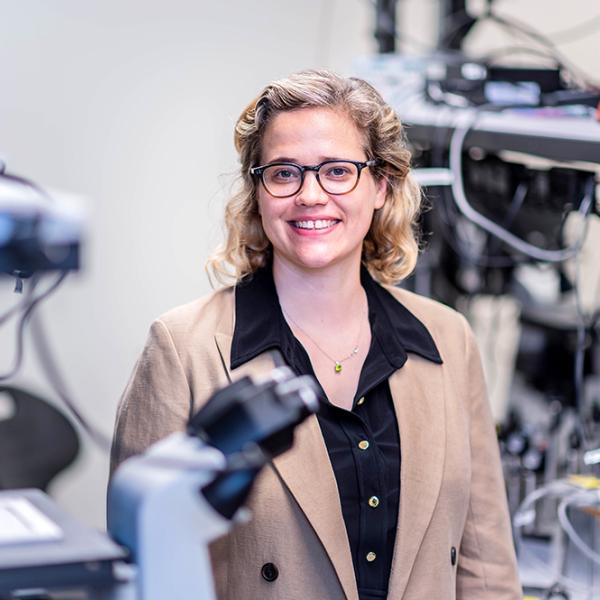Dr. Sabrina Leslie
Associate Professor, Michael Smith Laboratories
Department of Physics and Astronomy
Dr. Leslie's academic training began in 1998 as an undergraduate at UBC, where she immersed herself in the Combined Honours Physics and Mathematics Program, graduating as a Canada Scholar and recipient of the CK Choi Presidential Award. In 2002, she moved to UC Berkeley as an NSERC fellow to pursue doctoral studies in optical and atomic physics. Under the guidance of Dr. Dan Stamper-Kurn, she pioneered imaging experiments of disorder-to-order transitions of atomic vapours held in optical traps. Her PhD work was published in top journals and provided her with extensive training in instrumentation, imaging, data analysis, and team-based science. In 2009, she made a significant transition, from visualizing atoms in vacuum chambers, to visualizing biomolecules in liquids; a transition by a desire to get a little closer to life in her research. Her transition to the Department of Chemistry and Chemical Biology at Harvard University was made possible with a Mary Fieser postdoctoral fellowship, which was awarded with the mandate of exploring this inspiration. At Harvard, she invented a single-molecule imaging technology called Convex Lens-induced Confinement (CLiC), which established her as a pioneer in single-molecule investigations. In 2012, she became an Assistant Professor at McGill University and founded her research group. She developed CLiC into a platform technology and used it for new studies of nucleic acids, proteins, polymers, nanomaterials, biologics, cells, etc. Her time at McGill was productive and she was promoted to Associate Professor with tenure in 2017. To expand, commercialize, and protect her technology and key applications, she co-founded a start-up company ScopeSys, with a technical and business team based in Canada. In 2021, she moved her lab to UBC Vancouver as an Associate Professor in the Michael Smith Laboratories.
Research Focus
The Leslie Lab is working at the interface of physics and biology with a particular interest in quantifying the dynamics of individual molecules. Dr. Leslie’s research provides insights into the biophysical properties of molecules and cells, including therapeutics with the ultimate goal of propelling quantitative health sciences. Her team is developing single-molecule and single-cell imaging and analysis tools, as well as mathematical models of molecular interactions, to help guide the rational design of new therapeutic molecules and delivery vehicles. These discoveries will elucidate the process of how molecules search for and bind to a target and perform their therapeutic function in a complex living environment, with a particular focus on nucleic acid interactions and advancing genetic medicines. Current projects include: understanding the biophysics of nucleic acid hybridization, understanding the mechanisms of antisense oligonucleotides, protein-protein interactions, and single- molecule activity in whole cells.
Research Keywords
Single-molecule biophysics, Biotechnology, Fluorescence microscopy, Nucleic acid interactions, Nanoscale devices, Instrumentation and innovation, Oligonucleotide Therapeutics, Nanoparticle interactions and dynamics
